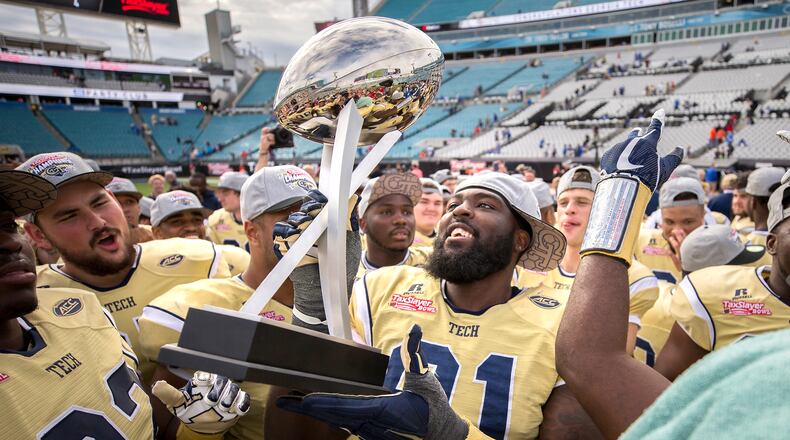The TaxSlayer Bowl was not yet two minutes old when Georgia Tech defensive tackle Patrick Gamble and linebacker P.J. Davis combined on one of the most decisive plays of the game. On a 3rd-and-2 from the Tech 49-yard line, Gamble forced a fumble from quarterback Stephen Johnson and Davis scooped up the ball and ran 38 yards for the game’s first touchdown.
The defensive score established the Yellow Jackets’ superiority over the Wildcats and forced them into chase mode for the entirety of the game, won 33-18 by Tech.
“I really thought that set us back early with the scoop for a touchdown,” Kentucky coach Mark Stoops said. “That’s very hard to overcome against Georgia Tech.”
It was Tech’s first defensive touchdown of the season and the second of Davis’ career, following his interception return for a touchdown against Virginia Tech in 2014. By scoring first, Tech improved to 51-15 under coach Paul Johnson when the Jackets score first.
On the play, Gamble beat right guard Jervontius Stallings as the Wildcats rolled their pocket left. Davis shot a gap in a delayed blitz and forced Johnson back into Gamble, who knocked the ball away as he tried to wrap him up. Davis picked up the ball in stride and ran to the goal line, twice nearly falling. Having two of Tech’s most dependable players over the last three seasons who were playing their final game in Tech uniforms jump start the game was fitting.
“Can’t think of a better way to start the game,” Paul Johnson said.
Over the afternoon, Tech’s pass-rush pressure limited Kentucky, whose deep game had concerned defensive coordinator Ted Roof. The Wildcats’ longest completion of the day went for 20 yards. Kentucky had had 34 pass plays of 20 yards or more coming into the game.
It was a most satisfying conclusion for a defense that had had difficulty pressuring the passer through much of the season. Johnson was 19 for 34 for 175 yards with one touchdown and two sacks.
“We had some shots,” Stoops said. “We didn’t get good protection, we really didn’t. We didn’t protect well enough to get the ball down the field.”
Tech’s final three opponents – Virginia, Georgia and Kentucky – had passing efficiency ratings under 110, which indicates exceptional pass defense. Tech had contributions at both ends Saturday, as pass rush pressure affected Johnson up front and coverage was likewise effective.
“We had to get pressure when they threw the ball,” Gamble said. “We knew they were going to run the ball. When it was time for them to throw the ball, we had to push and get some pressure.”
The Jackets’ run defense might have been even better. Kentucky ran 36 times for 149 yards, a 4.1 average. In the final seven games of the regular season, the Wildcats had been a run-game force, averaging 291 yards per game and 6.2 yards per carry.
About the Author
Keep Reading
The Latest
Featured


